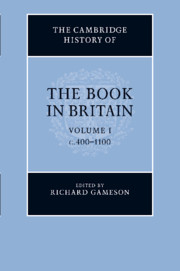Book contents
- Frontmatter
- 1 From Vindolanda to Domesday: the book in Britain from the Romans to the Normans
- PART I THE MAKING OF BOOKS
- PART II THE CIRCULATION OF BOOKS
- PART III TYPES OF BOOKS AND THEIR USES
- 15 The book in Roman Britain
- 16 The use of the book in Wales, c. 400–1100
- 17 The biblical manuscripts of Anglo-Saxon England
- 18 Anglo-Saxon gospel-books, c. 900–1066
- 19 Liturgical books
- 20 Anglo-Saxon prayerbooks
- 21 Psalters
- 22 Music books
- 23 Anglo-Saxon schoolbooks
- 24 Law books
- 25 Manuscripts of the Anglo-Saxon Chronicle
- 26 Old English homiliaries and poetic manuscripts
- PART IV COLLECTIONS OF BOOKS
- PART V CODA
- Bibliography
- Concordance of named manuscripts
- Index of manuscripts
- General Index
- Plate 4.1: The Lindisfarne Gospels"
- Plate 5.1: The Lichfield/St Chad Gospels"
20 - Anglo-Saxon prayerbooks
from PART III - TYPES OF BOOKS AND THEIR USES
Published online by Cambridge University Press: 28 March 2012
- Frontmatter
- 1 From Vindolanda to Domesday: the book in Britain from the Romans to the Normans
- PART I THE MAKING OF BOOKS
- PART II THE CIRCULATION OF BOOKS
- PART III TYPES OF BOOKS AND THEIR USES
- 15 The book in Roman Britain
- 16 The use of the book in Wales, c. 400–1100
- 17 The biblical manuscripts of Anglo-Saxon England
- 18 Anglo-Saxon gospel-books, c. 900–1066
- 19 Liturgical books
- 20 Anglo-Saxon prayerbooks
- 21 Psalters
- 22 Music books
- 23 Anglo-Saxon schoolbooks
- 24 Law books
- 25 Manuscripts of the Anglo-Saxon Chronicle
- 26 Old English homiliaries and poetic manuscripts
- PART IV COLLECTIONS OF BOOKS
- PART V CODA
- Bibliography
- Concordance of named manuscripts
- Index of manuscripts
- General Index
- Plate 4.1: The Lindisfarne Gospels"
- Plate 5.1: The Lichfield/St Chad Gospels"
Summary
The six prayerbooks that have survived from Anglo-Saxon England fall into two groups, the first of which belongs to the late eighth or early ninth century, while the second dates from the eleventh. These are not the only collections of prayers for private use, however. Wulfstan, bishop of Worcester, stated that everyone, lay people as well as religious, should know the Pater noster and Creed in English, if not in Latin, and followed this statement with a translation of the two texts. A verse translation of the Pater noster occurs in the Exeter Book and translations and expansions of the Pater noster, Gloria, and Apostles' Creed, are found in Cambridge, Corpus Christi College, 201, and Bodleian Library, Junius 121, the so-called Benedictine Office. A group of prayers in Old English, which are generally agreed to be by Ælfric and which include translations of the Pater noster, Apostles' Creed and Niceno-Constantinopolitan Creed, were copied in the late tenth or early eleventh century at the end of a manuscript of the Catholic Homilies thought to be close to Ælfric’s original copy. These prayers form what is effectively a small prayerbook, possibly intended, like the two sets of Catholic Homilies, for use by Ælfric’s patrons at Cerne Abbas. The first seven prayers are translated from texts found in manuscripts such as the Leofric Missal, the Missal of Robert of Jumièges, the Leofric Collectar or the Portiforium of St Wulfstan, and are in the plural form; the final three prayers, on the other hand, are based on biblical texts and are in the singular.
Keywords
- Type
- Chapter
- Information
- The Cambridge History of the Book in Britain , pp. 460 - 467Publisher: Cambridge University PressPrint publication year: 2011
- 1
- Cited by



